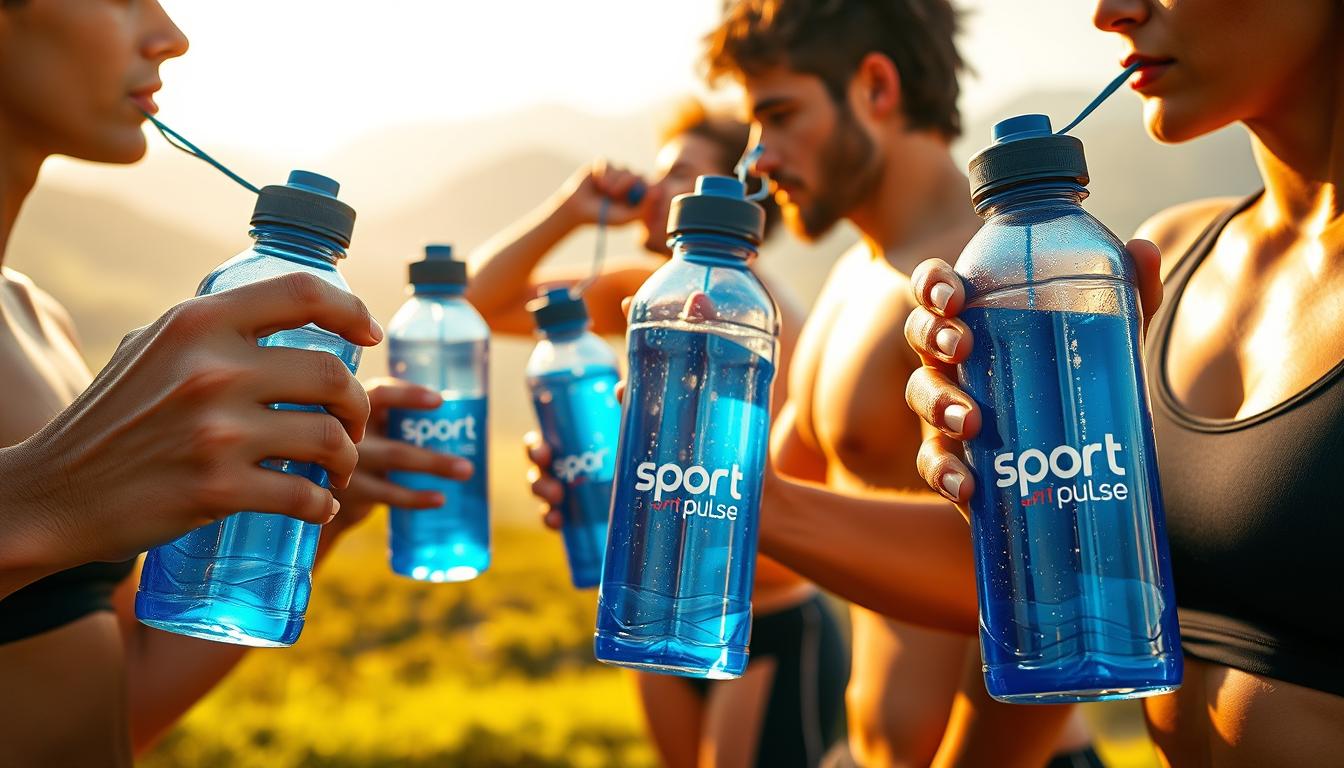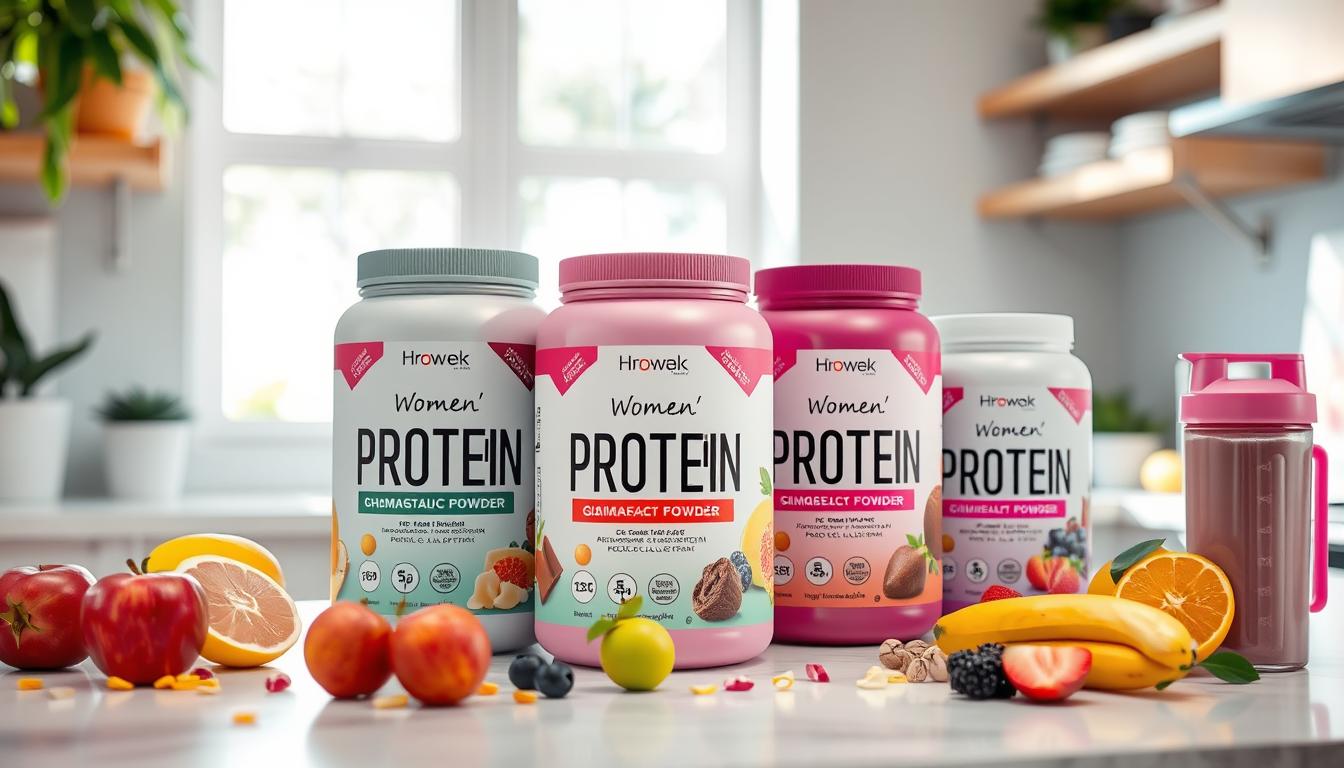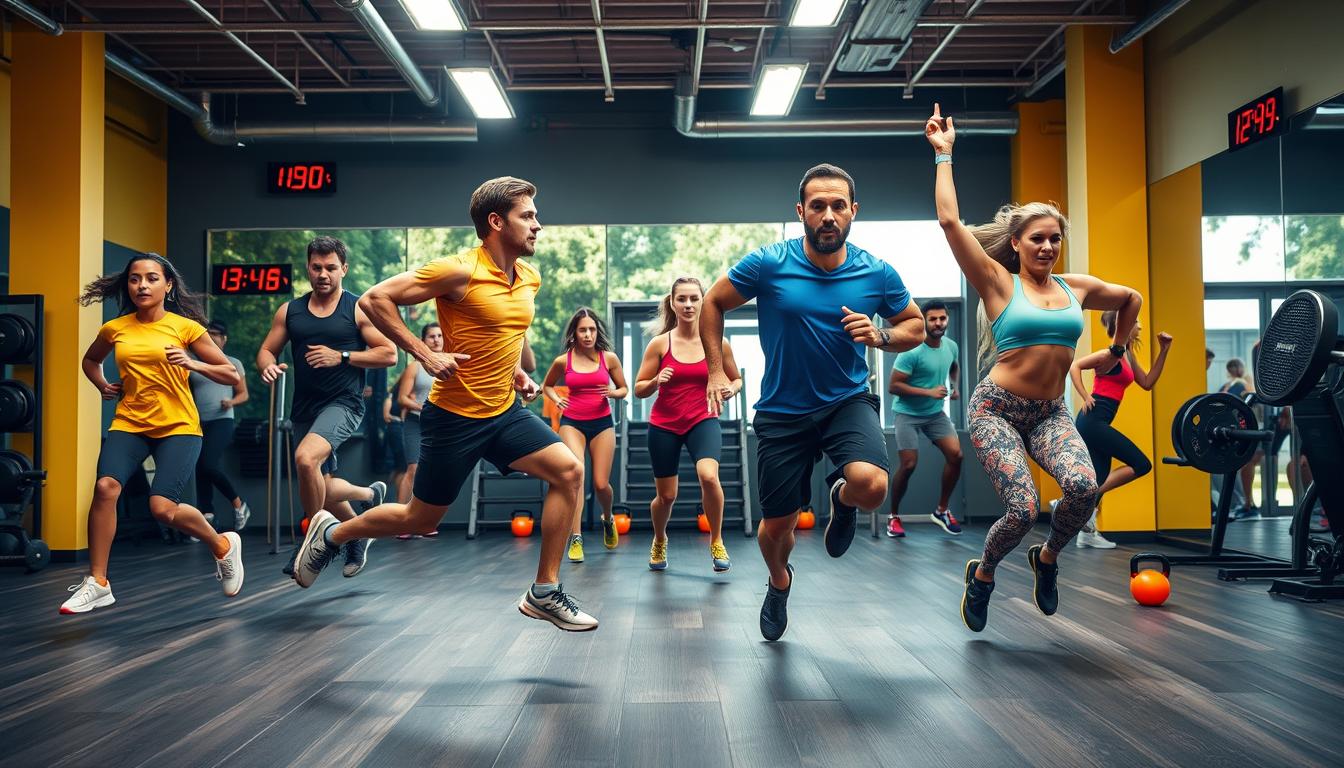Did you know that dehydration can significantly impair an athlete’s performance, causing a decline in both physical and mental capabilities? Water makes up approximately 60% of the human body, playing a crucial role in maintaining optimal athletic performance.
For athletes, hydration is not just about drinking water; it’s about understanding its impact on their performance and overall health. Dehydration can lead to decreased endurance, strength, and speed, ultimately affecting an athlete’s ability to perform at their best in various sports.
Maintaining optimal hydration levels is essential for athletes to achieve peak performance. This comprehensive guide will explore the science behind hydration’s impact on physical performance and provide practical strategies for hydration before, during, and after exercise.
Key Takeaways
- Understand the role of water in the human body and its impact on athletic performance.
- Learn how dehydration affects physical and mental capabilities.
- Discover strategies for maintaining optimal hydration levels.
- Explore the science behind hydration’s impact on muscle function and cognitive abilities.
- Find out how to maximize your athletic potential through proper hydration techniques.
The Science Behind Hydration and Athletic Performance
The relationship between hydration and athletic performance is rooted in complex physiological processes. To understand how hydration affects performance, it’s essential to delve into the science behind it.
How Water Functions in the Body
Water is a vital component of the human body, making up approximately 60% of an adult’s body weight. It plays a crucial role in various bodily functions, including regulating body temperature, transporting nutrients and oxygen to cells, and removing waste products. During exercise, the body loses water through sweat, which can lead to dehydration if not properly managed. As stated by a recent study, “even mild dehydration can significantly impair athletic performance across all types of sports and activities.” Proper hydration is essential for maintaining optimal bodily functions, particularly during physical activity.
When the body is properly hydrated, the cardiovascular system functions more efficiently, allowing for better oxygen delivery to working muscles and improved endurance. This is because hydration helps maintain blood volume and viscosity, which is essential for efficient nutrient delivery and waste removal during exercise. The importance of hydration cannot be overstated, as it directly affects an athlete’s ability to perform at their best.
The Connection Between Hydration and Physical Performance
Research has consistently shown that there is a direct connection between body water deficits and an athlete’s ability to generate upper and lower body anaerobic power. For instance, a body water deficit of just 2.9% can significantly impact an athlete’s performance.
“The relationship between hydration and performance follows a dose-response pattern—the more dehydrated an athlete becomes, the more pronounced the performance decrements.”
This highlights the importance of maintaining optimal hydration levels, especially for athletes competing in high-intensity events.
- Even mild dehydration can significantly impair athletic performance.
- Proper hydration is crucial for maintaining blood volume and viscosity.
- Hydration status directly affects cognitive function and reaction time.
- Hydrated athletes experience lower perceived exertion levels during exercise.
By understanding the science behind hydration and its impact on physical performance, athletes can take steps to optimize their hydration levels and improve their overall performance.
The Importance of Proper Hydration for Optimal Athletic Performance
Optimal athletic performance is closely linked to adequate hydration. When athletes are properly hydrated, their bodies can function at their best, allowing for improved endurance, strength, and overall physical capability. Proper hydration is essential for maintaining the delicate balance of fluids within the body, which is critical for optimal physical performance.
Performance Benefits of Proper Hydration
Proper hydration offers numerous benefits for athletes, enhancing their performance in various ways. Adequate fluid intake ensures that the body’s physiological processes operate efficiently. This includes regulating body temperature, transporting nutrients and oxygen to cells, and removing waste products. When athletes are well-hydrated, they can perform at higher intensities and recover more effectively between exercises.
Hydration also plays a critical role in maintaining athletic performance by supporting cardiovascular function and muscle operation. Even mild dehydration can cause a decline in performance, as it stresses the cardiovascular system and impairs the body’s ability to cool itself. Thus, maintaining proper hydration is vital for athletes seeking to optimize their exercise performance.
Health Risks of Inadequate Hydration
Inadequate hydration can lead to a range of health issues for athletes, from mild discomfort to serious medical conditions. Dehydration can cause symptoms such as dry mouth, fatigue, and muscle cramps. More severe dehydration can lead to heat exhaustion or heat stroke, both of which are potentially life-threatening conditions.
Athletes who consistently train while dehydrated may also face long-term health consequences, including kidney damage and an increased risk of urinary tract infections. Furthermore, dehydration can impair cognitive function, affecting decision-making and reaction times, which can be particularly problematic during competitive events.
- Inadequate hydration places significant stress on the cardiovascular system.
- Dehydration increases the risk of musculoskeletal injuries.
- Heat-related illnesses become more likely when athletes are dehydrated.
Understanding Dehydration in Athletes
Understanding dehydration is crucial for athletes to maintain peak performance and avoid health risks. Dehydration occurs when the body loses more fluids than it takes in, causing an imbalance in the body’s water and electrolyte levels.
Common Signs and Symptoms
Athletes need to be aware of the common signs and symptoms of dehydration. These include dry mouth, fatigue, dizziness, and dark-colored urine. Recognizing these symptoms early can help athletes take prompt action to rehydrate and avoid more severe dehydration.
Some other signs include headaches and muscle cramps, which can significantly impact an athlete’s ability to perform during exercise.
Performance Impacts of Dehydration
Dehydration can have significant impacts on an athlete’s performance. Research has shown that even mild dehydration can lead to a decline in aerobic and anaerobic performance. For instance, a loss of just 2% body weight due to dehydration can reduce aerobic performance by 10-20% and anaerobic performance by 3-5%.
- Endurance capacity is particularly sensitive to hydration status, with time to exhaustion decreasing significantly even with mild dehydration.
- Technical skill execution becomes impaired as dehydration progresses, affecting accuracy, coordination, and sport-specific skills crucial for optimal performance.
- The body’s ability to cool itself through sweat is also compromised, increasing the risk of heat-related illnesses during exercise.
By understanding the impacts of dehydration, athletes can take proactive steps to maintain proper hydration and optimize their performance.
How Dehydration Affects Your Athletic Abilities
Dehydration can significantly impact an athlete’s performance, affecting various bodily functions crucial for optimal athletic ability. When the body loses more fluids than it takes in, it can disrupt the delicate balance necessary for peak performance. This imbalance can manifest in several ways, affecting different aspects of an athlete’s capabilities.
Cardiovascular Effects
Dehydration can lead to a decrease in blood volume, causing the heart to work harder to supply oxygen to the muscles. This strain on the cardiovascular system can result in reduced endurance and increased fatigue. As dehydration worsens, athletes may experience dizziness or lightheadedness, further compromising their performance.
| Cardiovascular Parameter | Normal State | Dehydrated State |
|---|---|---|
| Heart Rate | 60-100 bpm | Increased |
| Blood Pressure | 120/80 mmHg | Decreased |
| Cardiac Output | Optimal | Reduced |
Muscular Function and Strength
Dehydration also affects muscular function, leading to cramps, weakness, and reduced strength. Even mild dehydration can cause a significant decline in muscular performance, as the muscles require adequate hydration to function optimally. This is particularly critical in sports that require quick bursts of energy or sustained strength over time.
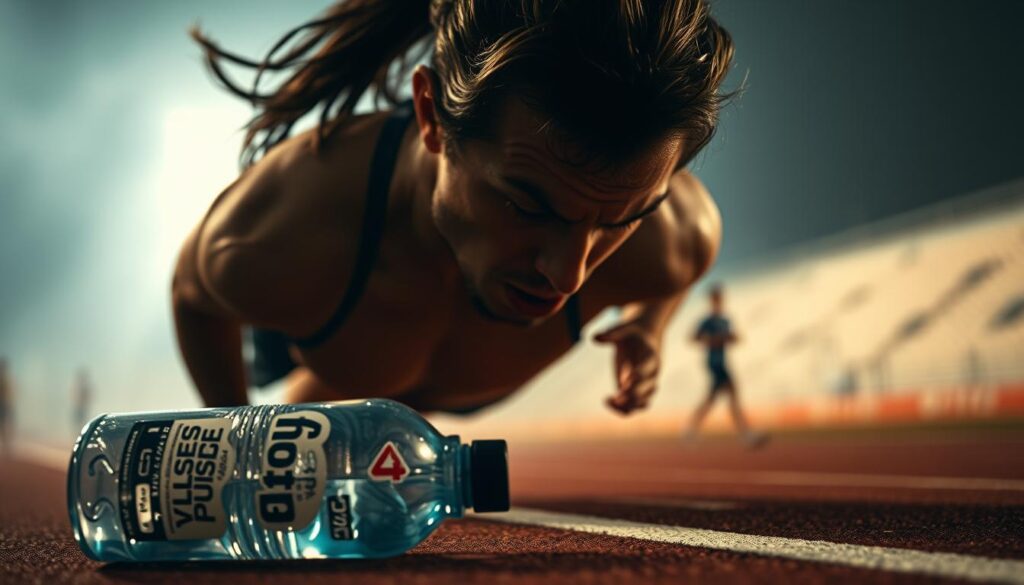
Cognitive Performance and Focus
Cognitive function is another area significantly impacted by dehydration. Athletes may experience reduced concentration, impaired decision-making, and increased reaction times. As dehydration progresses, these cognitive impairments can become more pronounced, potentially leading to tactical errors or accidents during competition. The brain’s sensitivity to hydration status means that even slight dehydration can affect cognitive performance before noticeable physical symptoms appear.
By understanding how dehydration affects athletic abilities, athletes can take proactive steps to maintain proper hydration levels, thereby safeguarding their performance and overall health.
The Role of Electrolytes in Athletic Hydration
Proper hydration is not just about drinking water; it’s also about maintaining the right balance of electrolytes. Electrolytes are minerals that carry an electric charge and are crucial for various bodily functions, including nerve and muscle function, hydration, and pH balance.
Key Electrolytes for Athletes
Athletes need to be particularly aware of several key electrolytes lost in sweat. Sodium is one of the most important, as it helps regulate the amount of water in the body and maintains proper fluid balance. Other crucial electrolytes include potassium, calcium, and magnesium, which are vital for muscle function and nerve transmission.
As “Drinking too much plain water during prolonged exercise can lead to hyponatremia, a condition where the sodium levels in the blood become dangerously low.” This highlights the importance of balancing water intake with electrolyte replacement, especially during long or intense activities.
Electrolyte Balance and Performance
Maintaining the right electrolyte balance is essential for optimal performance. Electrolyte imbalances can lead to muscle cramps, weakness, and irregular heartbeat. Sports drinks are designed to help replace lost electrolytes and are particularly useful during prolonged or high-intensity exercise.
The ideal electrolyte replacement strategy varies based on individual sweat rate, exercise duration, and environmental conditions. For activities lasting less than 60-90 minutes, hydration with plain water may be sufficient, but for longer or more intense activities, sports drinks can help maintain the necessary electrolyte balance.
Hydration Strategies Before Exercise
To achieve optimal performance, athletes must prioritize their hydration before training or competition. Proper hydration is essential for physical performance and overall health.
Pre-Workout Hydration Timeline
Athletes should start hydrating 3-4 hours before exercise. The general recommendation is to consume 5-7ml of fluid per kg of body weight during this period. For example, an athlete weighing 70kg should aim to drink 350-490ml of fluid.
It’s also important to consider the temperature of the fluid. The ideal temperature for pre-exercise consumption is between 50-59°F, as it enhances palatability and helps lower core temperature slightly.
Optimal Fluid Types and Amounts
The type and amount of fluid an athlete consumes before exercise depend on the duration and intensity of the activity. For activities lasting less than 60-90 minutes in moderate conditions, water is sufficient for pre-exercise hydration.
For longer or more intense sessions, especially in hot environments, sports drinks containing 6-8% carbohydrate concentration and 200-300mg of sodium per 16oz provide optimal hydration and energy. When selecting a sports drink, look for one with 10-14 grams of carbohydrate per 8 ounces and 200-300 milligrams of sodium per 16 ounces.
| Activity Duration | Recommended Fluid | Key Components |
|---|---|---|
| Less than 60-90 minutes | Water | – |
| Longer or more intense | Sports drinks | 6-8% carbohydrate, 200-300mg sodium per 16oz |
Athletes with high sweat rates or known sodium losses may benefit from adding additional electrolytes to their pre-exercise hydration strategy. Hypotonic solutions are absorbed more quickly and may be preferable when rapid hydration is needed.
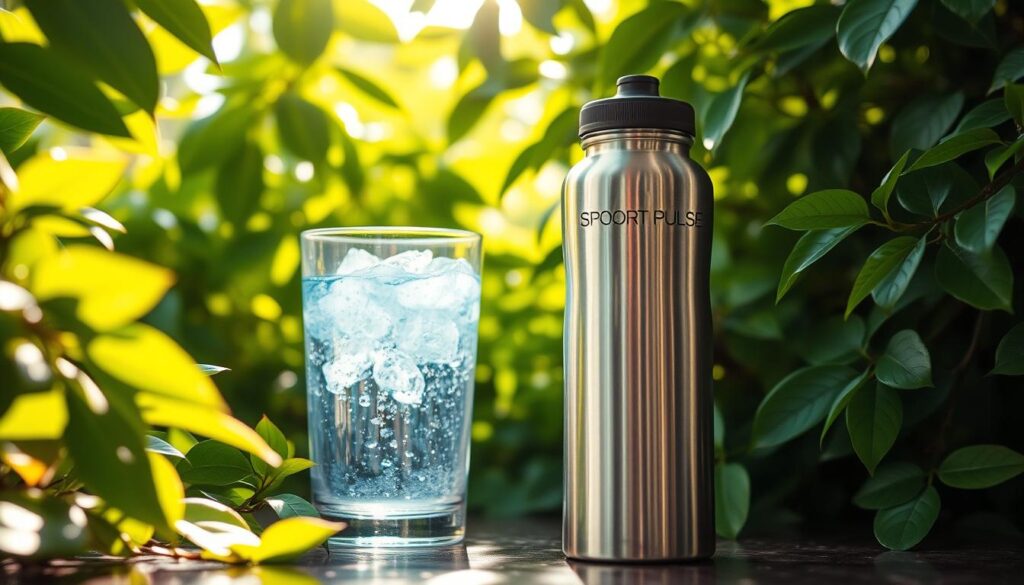
Maintaining Hydration During Training and Competition
Maintaining proper hydration is crucial during both training and competition to ensure athletes can perform at their best. Adequate hydration helps regulate body temperature, transport nutrients and oxygen to cells, and remove waste products.
Scheduled Drinking vs. Drinking to Thirst
Athletes often debate whether to drink according to a schedule or to drink when they feel thirsty. Scheduled drinking involves consuming fluids at regular intervals, regardless of thirst. This approach can help prevent dehydration by ensuring consistent fluid intake. On the other hand, drinking to thirst relies on the body’s natural thirst mechanism to guide fluid intake.
- Scheduled drinking can help maintain hydration levels, especially during intense or long-duration activities.
- Drinking to thirst is more intuitive and can be effective for shorter or less intense activities.
Practical Tips for In-Exercise Hydration
To stay hydrated during exercise, athletes should follow these practical tips:
- Consume 3-8oz (90-240ml) of fluid every 15-20 minutes during exercise, adjusting based on individual sweat rates and environmental conditions.
- For activities lasting less than 60 minutes in moderate conditions, water is typically sufficient for maintaining hydration.
- For longer duration activities or exercise in hot/humid environments, sports drinks containing 6-8% carbohydrate and 200-700mg/L of sodium help replace electrolytes and provide energy.
By following these guidelines and practicing hydration strategies during training, athletes can optimize their fluid intake and maintain peak performance during competition.
Post-Exercise Rehydration Techniques
Proper post-exercise rehydration is essential for maintaining peak athletic performance and overall health. When athletes engage in strenuous physical activity, they lose significant amounts of water and electrolytes through sweat. Replenishing these losses is critical for recovery, subsequent performance, and overall well-being.
Calculating Fluid Replacement Needs
To effectively rehydrate, athletes need to calculate their fluid replacement needs. A general guideline is to drink 1.5 times the total body weight lost during exercise. This fluid should contain sodium to promote fluid retention and prevent excessive urine production.
For instance, if an athlete loses 2 pounds during a workout, they should consume 3 pounds (or approximately 48 ounces) of fluid. This approach helps ensure that the athlete replenishes lost fluids and supports the recovery process.
Recovery Drinks and Their Benefits
The choice of rehydration fluid is also important. Optimal recovery drinks contain both carbohydrates and protein in a 3:1 or 4:1 ratio to replenish glycogen stores and support muscle repair. Sodium content is crucial as it helps retain fluid and stimulates thirst.
Milk, particularly chocolate milk, has gained popularity as a natural recovery drink due to its ideal carbohydrate-to-protein ratio, fluid content, and natural electrolytes. Commercial recovery drinks typically contain 6-8% carbohydrate concentration, 10-20g of protein, and 200-300mg of sodium per 16oz serving.
| Rehydration Drink | Carbohydrate Content | Protein Content | Sodium Content |
|---|---|---|---|
| Chocolate Milk | 30g per 16oz | 8g per 16oz | 150mg per 16oz |
| Commercial Recovery Drink | 6-8% concentration | 10-20g per 16oz | 200-300mg per 16oz |
| Tart Cherry Juice | 40g per 16oz | 1g per 16oz | 10mg per 16oz |
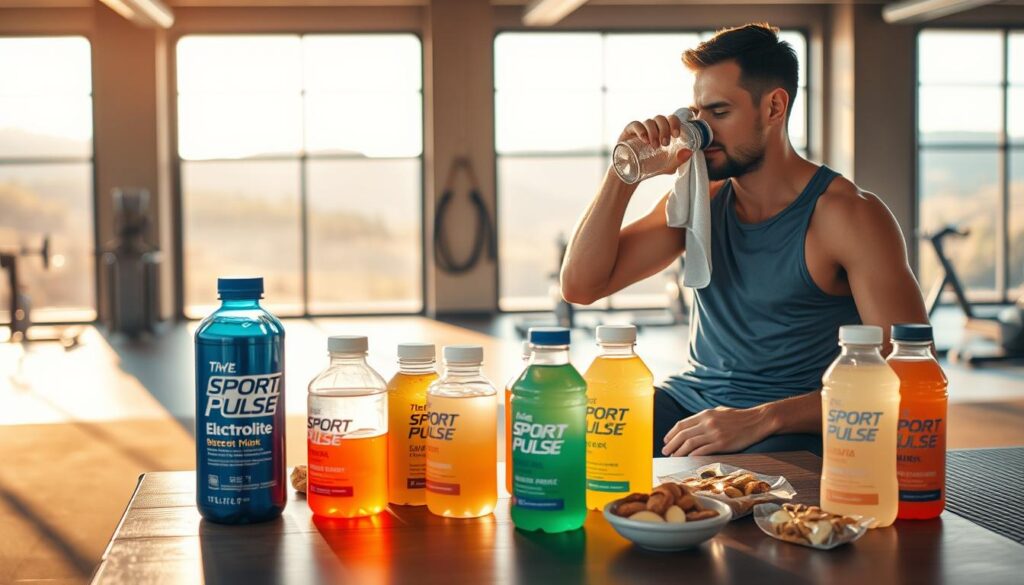
The timing of recovery drinks is also critical, with the greatest benefits seen when consumed within 30 minutes after exercise. For athletes training multiple times per day, recovery drinks become even more critical to rapidly restore hydration status and energy stores between sessions.
tag.
6. Developing a keyword placement matrix:
I will ensure that the keywords (“sports drinks,” “sodium,” “carbohydrate,” “hydration,” “water,” “body,” “exercise,” “sweat”) are used appropriately, with a density of up to 2%.
7. Creating short paragraphs for readability:
I will break down the content into short paragraphs and ensure that the Flesch Reading Ease and Flesch-Kincaid Grade are within the recommended range.
8. Keeping in mind the recommended text size (300 words) and headings (H2, H3).
Here’s the content for Section 10:
Water vs. Sports Drinks: Making the Right Choice
When it comes to hydration during exercise, athletes often face a dilemma: should they opt for water or sports drinks? The answer depends on several factors, including the intensity and duration of the exercise, as well as individual needs.
When Water Is Sufficient
For low-to-moderate intensity exercises that last less than an hour, water is usually sufficient for hydration. It’s easily accessible and effectively replenishes fluids lost during casual workouts or daily activities. Water is the best choice when the exercise is not intense enough to cause significant electrolyte loss through sweat.
When Sports Drinks Are Beneficial
Sports drinks become beneficial during prolonged or high-intensity exercises, especially in hot conditions where athletes lose significant amounts of sweat and electrolytes. These drinks help replenish carbohydrate stores and maintain electrolyte balance, which is crucial for performance and recovery.
What to Look for in a Sports Drink
When choosing a sports drink, look for one that contains between 10 to 14 grams of carbohydrate per 8 ounces. The sodium content should be around 200-300 milligrams per 16 ounces. Drinks like Gatorade and Powerade are standard options, but the ideal composition can vary based on individual needs and the specific demands of the exercise.
Athletes should consider their specific needs, including the type and duration of their exercise, to make an informed decision between water and sports drinks.
Calculating Your Individual Hydration Needs
To maximize your athletic potential, it’s vital to determine your specific hydration needs. Athletes have different fluid requirements based on various factors, including body size, sweat rate, environmental conditions, and individual tolerance.
A general guideline for daily fluid intake is to consume 30ml per kg of body mass, plus an additional 500ml-1L per hour of exercise. However, this is just a starting point, and individual needs may vary significantly.
Sweat Rate Calculation Methods
One effective way to determine your hydration needs is by calculating your sweat rate. This involves measuring your body weight before and after exercise, taking into account any fluids consumed during the activity. The difference in weight, combined with fluid intake, helps estimate your sweat rate. For instance, if you lose 1 kg (1 liter) of body weight during an hour-long workout and consume 0.5 liters of fluid, your sweat rate would be 1.5 liters per hour.
Adjusting Intake Based on Personal Factors
Several personal factors influence hydration needs. Body size significantly impacts fluid requirements, with larger athletes needing more fluid due to higher sweat rates. Individual sweat rates can vary dramatically, ranging from 0.5L/hr to over 3L/hr, even among athletes performing the same exercise in identical conditions.
Genetic factors also play a role, affecting both sweat rate and composition. Acclimatization to heat reduces sweat sodium concentration over time, potentially allowing for adjustments in electrolyte replacement strategies. Other factors such as menstrual cycle phases in female athletes, certain medical conditions like diabetes, and age can also impact hydration requirements.
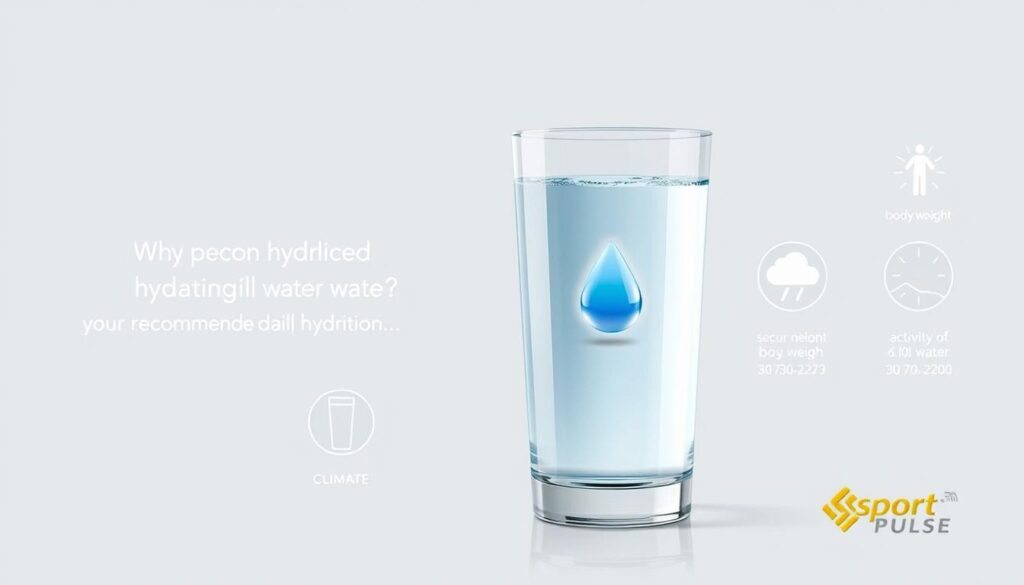
By understanding these factors and calculating your sweat rate, you can adjust your fluid intake to meet your individual needs, thereby optimizing your athletic performance.
Environmental Factors Affecting Hydration
Hydration needs are significantly influenced by the environment in which athletes train and compete. Various environmental conditions can impact the body’s fluid balance, making it crucial for athletes to adjust their hydration strategies accordingly.
Training in Hot and Humid Conditions
Training in hot and humid environments increases sweat rate, leading to higher fluid losses. Athletes need to drink more fluids to compensate for these losses and maintain proper hydration. Monitoring body weight and urine color can help determine if fluid intake is adequate.
Cold Weather Hydration Challenges
Even in cold weather, athletes can lose significant amounts of fluid. Increased respiratory water loss due to higher breathing rates in cold, dry air contributes to dehydration. Athletes should be aware of this and adjust their fluid intake to prevent dehydration.
Altitude and Hydration Considerations
At high altitudes, several factors contribute to increased fluid losses. These include:
- Increased respiratory water loss due to greater ventilation rates and lower humidity.
- Diuresis, or increased urine production, during the initial days at altitude.
- A natural decrease in plasma volume as part of the acclimatization process.
Athletes at altitude need to be mindful of these factors and increase their fluid intake accordingly. Proper hydration is critical to maintaining cardiovascular function and reducing the risk of acute mountain sickness (AMS).
By understanding and addressing the environmental factors that affect hydration, athletes can optimize their performance and reduce the risk of dehydration-related issues.
Monitoring Your Hydration Status
Monitoring hydration status is crucial for athletes to maintain peak performance. Proper hydration is essential for optimal athletic performance, and tracking hydration levels can help prevent dehydration and its negative effects on the body.
Urine Color and Volume Assessment
A simple and effective way to monitor hydration is by assessing urine color and volume. If the urine is pale yellow and plentiful, it’s a good sign of proper water intake. Dark yellow or scanty urine may indicate dehydration.
Body Weight Tracking Methods
Another method is tracking body weight before and after exercise to estimate fluid loss. A weight loss of 1-2% can indicate mild dehydration, while a loss of 3-5% or more can significantly impair performance.
| Weight Loss (%) | Dehydration Level | Performance Impact |
|---|---|---|
| 1-2% | Mild | Minimal |
| 3-5% | Moderate | Significant |
| >5% | Severe | Serious |
Other Hydration Monitoring Techniques
Several other techniques can be used to monitor hydration status, including:
- Bioelectrical impedance analysis (BIA) devices to estimate total body water
- Blood markers like plasma osmolality to measure hydration status
- Salivary osmolality as a less invasive alternative
- Tear osmolality as a potential biomarker
- Heart rate monitoring during exercise
- Wearable technology to analyze sweat composition and rate
- Thirst scales as a subjective measure
These methods provide athletes with various options to monitor their hydration status effectively.
Sport-Specific Hydration Strategies
Athletes across various sports disciplines face distinct hydration challenges that require tailored strategies. Proper hydration is essential for optimal performance and overall health, but the specific needs can vary significantly depending on the sport.
Endurance Sports
Endurance athletes, such as marathon runners and cyclists, engage in prolonged activities that lead to significant fluid loss through sweat. Hydration plans for these athletes should focus on both the quantity and timing of fluid intake. It’s crucial to start exercise well-hydrated and to drink fluids at regular intervals during activity to replace lost sweat.
Team and Power Sports
Team sports like soccer, basketball, and football, as well as power sports such as weightlifting, involve high-intensity efforts over shorter durations. These athletes need to focus on rapid rehydration between rounds or during breaks in play. Electrolyte-rich drinks can be beneficial for replenishing lost salts.
Water Sports and Swimming
Water sports athletes, including swimmers, face unique hydration challenges. Despite being in the water, they can still lose significant amounts of fluid through sweat. It’s essential for these athletes to monitor their hydration status closely, as the sensation of thirst can be masked by the water environment. For instance, swimmers can lose 0.5-1.0L of fluid per hour during intense training. Practical strategies include having water bottles at pool ends and focusing on post-training rehydration.
As noted by experts, “In the pool, it’s interesting because we could be sweating just as much as we are when we’re not in the pool, but we’re not getting as thirsty and we’re not seeing that sweat.” This highlights the need for water sports athletes to be proactive about their hydration.
Hydration for Young Athletes
Young athletes have unique hydration needs that must be addressed to ensure optimal performance and well-being. Children and teenagers are more susceptible to overheating and dehydration due to their developing bodies. Therefore, it is crucial to implement effective hydration strategies tailored to their needs.
Special Considerations for Children and Teens
Actually, kids overheat faster than adults, so ensuring they are well-hydrated is critical. Providing cold, flavored beverages can encourage them to drink more. Coaches and parents should remind young athletes to drink at regular intervals, especially in hot conditions, and offer frequent breaks. This proactive approach helps prevent dehydration and maintains their performance levels.
Key factors to consider include: making hydration enjoyable, providing accessible drinking water, and monitoring their fluid intake closely.
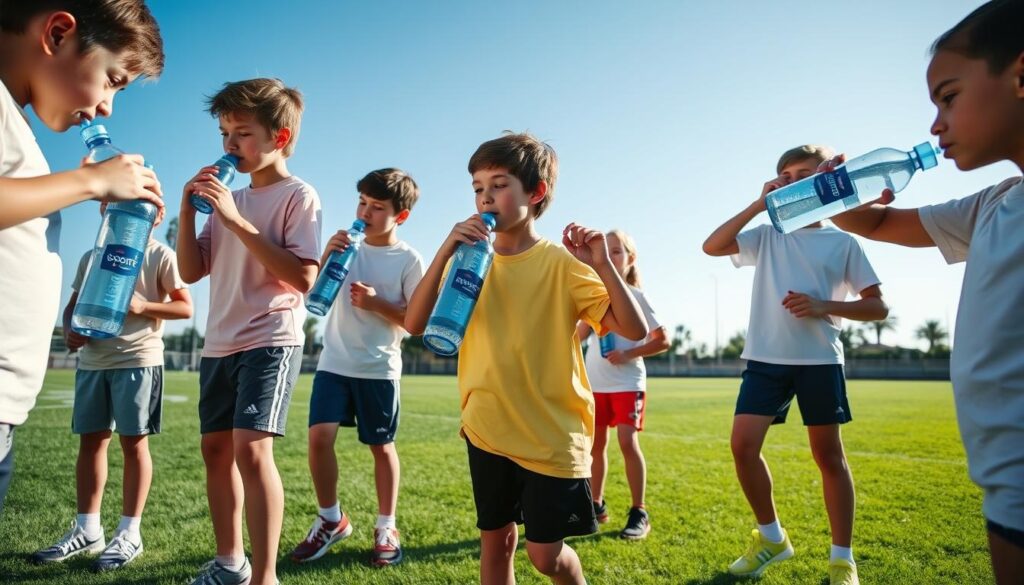
Educating Young Athletes About Hydration
Education is vital in helping young athletes understand the importance of hydration. Teaching them to monitor their urine color, recognize early signs of dehydration, and develop a routine for drinking water can establish lifelong healthy habits. Using visual aids like urine color charts and personalized water bottles can make hydration more engaging.
Involving parents and coaches in hydration education creates a supportive environment that reinforces good hydration practices. By explaining the benefits of proper hydration in terms relevant to their sport, young athletes are more likely to be motivated to maintain good hydration habits.
Common Hydration Myths Debunked
Proper hydration is essential for peak athletic performance, yet numerous myths cloud the understanding of how to achieve it. Athletes often follow various hydration strategies, some of which are based on misconceptions rather than scientific evidence. Understanding the truth behind these myths can help athletes optimize their hydration and improve their performance.
“Eight Glasses a Day” and Other Misconceptions
The notion of drinking eight glasses of water a day is a common hydration guideline, but it lacks scientific backing. The actual fluid needs of individuals vary greatly depending on factors such as body size, activity level, and environmental conditions. A more effective approach is to monitor individual signs of hydration, such as urine color and body weight changes, rather than adhering to a one-size-fits-all recommendation.
- Urine color can be a good indicator of hydration status, with pale yellow suggesting proper hydration.
- Monitoring body weight before and after exercise can help determine fluid loss and guide rehydration efforts.
The Truth About Caffeine and Hydration
Caffeine is often misunderstood as a significant diuretic that leads to dehydration. However, research has shown that moderate caffeine intake, defined as up to 400mg daily (approximately 3-4 cups of brewed coffee), does not substantially impact overall hydration status in habitual consumers. While caffeine does have mild diuretic effects, the fluid in caffeinated beverages compensates for the increased urine production in most cases.
- Caffeine’s diuretic effect diminishes with habitual consumption due to developed tolerance.
- During exercise, caffeine’s performance-enhancing benefits often outweigh its minor diuretic effects.
- Caffeinated beverages can contribute to daily fluid intake, but should not replace non-caffeinated options entirely.
Conclusion: Mastering Hydration for Peak Athletic Performance
Proper hydration stands as a cornerstone of athletic success, influencing every aspect of physical performance. As we’ve explored, hydration impacts every physiological system involved in exercise, from cardiovascular function to muscle contraction and cognitive processing.
To optimize performance, athletes must develop individualized hydration strategies based on personal sweat rates, environmental conditions, and sports-specific demands. This proactive approach to hydration is crucial for maintaining fluid balance throughout training and minimizing health risks.
Monitoring hydration status through multiple methods, such as urine color and body weight changes, provides a comprehensive understanding of the body’s water needs. For personalized guidance on optimizing hydration for your specific needs and goals, reach out via WhatsApp at +44-7822010953 to consult with our hydration specialists. Learn more about the importance of hydration in athletic performance by visiting our detailed guide on hydrated athletic performance.
By mastering hydration—focusing on the right fluids, in the right amounts, at the right times—athletes can unlock their full potential and achieve peak performance in their respective sports.
